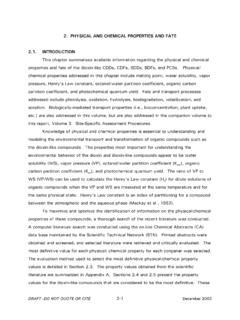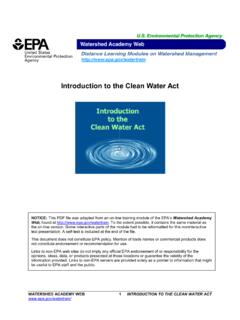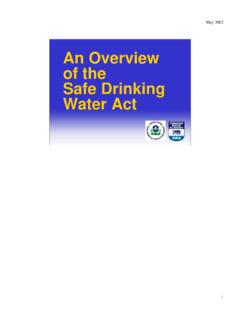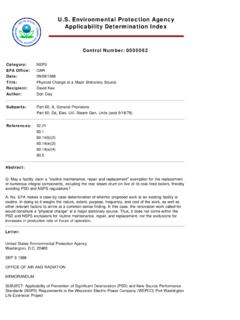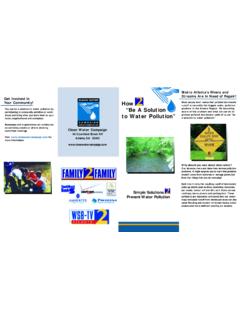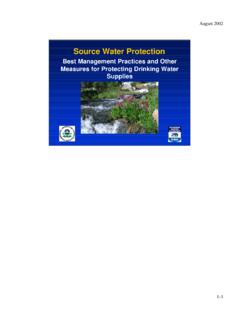Transcription of NOTICE: This PDF file was adapted from an on-line training ...
1 WATERSHED ACADEMY WEB Introduction to Watershed Ecology 1 NOTICE: This PDF file was adapted from an on-line training module of the EPA s Watershed Academy Web, found at To the extent possible, it contains the same material as the on-line version. Some interactive parts of the module had to be reformatted for this noninteractive text presentation. A self-test is included at the end of the file. This document does not constitute EPA policy. Mention of trade names or commercial products does not constitute endorsement or recommendation for use. Links to non-EPA web sites do not imply any official EPA endorsement of or responsibility for the opinions, ideas, data, or products presented at those locations or guarantee the validity of the information provided. Links to non-EPA servers are provided solely as a pointer to information that might be useful to EPA staff and the public.
2 WATERSHED ACADEMY WEB Introduction to Watershed Ecology 2 Introduction This training module introduces watershed ecology. Understanding watershed structure and natural processes is crucial to grasping how human activities can degrade or improve the condition of a watershed, including its water quality, its fish and wildlife, its forests and other vegetation, and the quality of community life for people who live there. Knowing these watershed structural and functional characteristics and how people can affect them sets the stage for effective watershed management. After completing this training , the participant should know the basic biotic and abiotic components of watersheds, the basic natural processes and interrelationships occurring in watersheds, and how watershed structure and functions may vary in time and space.
3 Some background in the life sciences is helpful for comprehending this material, but not required. Goals The aims of this unit are to: 1. Introduce terms and concepts associated with watershed ecology. 2. Describe typical watershed structure and how watersheds work, at different geographic scales and through time. 3. Provide related examples of contemporary issues in watershed ecology. Definitions Watershed. An area of land that drains water, sediment and dissolved materials to a common receiving body or outlet. The term is not restricted to surface water runoff and includes interactions with subsurface water. Watersheds vary from the largest river basins to just acres or less in size. Watershed Ecology. The study of watersheds as ecosystems , primarily the analysis of interacting biotic and abiotic components within a watershed s boundaries.
4 Ecosystem. A functioning natural unit with interacting biotic and abiotic components in a system whose boundaries are determined by the cycles and flux of energy, materials and organisms. It is valid to describe different ecosystems with different, overlapping sets of boundaries in the same geographic area ( forest ecosystems , watershed ecosystems and wetland ecosystems ). A watershed is just one of many types of ecosystems . Watershed ecology is essential knowledge for watershed managers because it teaches us that watersheds have structural and functional characteristics that can influence how human and natural communities coexist within them. The gross structure of a watershed -- its headwaters area, side slopes, valley floor, and water body, as well as its soils, minerals, native plants and animals -- are, in one sense, raw material for all the human activities that may potentially occur there (Figure 1).
5 The watershed s natural processes -- rainfall runoff, groundwater recharge, sediment transport, plant succession, and many others -- provide beneficial services when functioning properly, but may cause disasters when misunderstood and disrupted. It is crucial for WATERSHED ACADEMY WEB Introduction to Watershed Ecology 3people to understand watersheds and how they work before they make decisions or take actions that may affect important watershed structural or functional characteristics. This module introduces watershed ecology by covering the following topics (Figure 2): Major landscape-defining processes: the physical template. This section covers the physical processes which are shaping forces of ecosystems .
6 Climate, hydrology, and geomorphology provide the template upon which all life is ultimately based. The biological setting. This section discusses the terms and concepts associated with ecosystem science as it relates to living plant and animal communities. Natural systems concept. This section discusses how watersheds behave as natural systems and describes how different-sized watersheds operate on various spatial and temporal scales. This section also introduces structure and function, two vital concepts for understanding and managing watersheds and ecosystems . Watershed structure. This section defines the various patterns of physical structure formed by both the living and non-living watershed components. Watershed functions. This section covers watershed functions and processes -- vital cyclic events necessary to the continuation of life in aquatic and terrestrial systems, and the source of substantial ecological services and benefits to our human communities as well.
7 Figure 1. People need to learn about useful natural processes in watersheds to keep getting the benefits of these processes while avoiding harm to themselves and their property. Figure 2. Five main elements of watershed ecology WATERSHED ACADEMY WEB Introduction to Watershed Ecology 4 The Physical Template Within the watershed, various forms of matter, including water, are in constant cyclic flow. Through these processes, an abiotic (non-living) template of air, water, and soil is formed, upon which life can exist. The physical template of watershed structure is ultimately determined by varying combinations of climatic, geomorphic, and hydrologic processes (Figure 3). Climatology, the science of climate and its causes, becomes important in understanding regional issues in watershed science (Figure 4).
8 Though sometimes used synonymously with weather, climate is actually a distinct term with important ecological ramifications. Climate refers to an aggregate of both average and extreme conditions of temperature, humidity, and precipitation (including type and amount), winds, and cloud cover, measured over an extended period of time. Weather refers to present-day environmental conditions; current temperatures and meteorological events make up weather, not climate. Long-term weather trends establish averages which become climatic regimes. Climate heavily influences watershed vegetation communities, streamflow magnitude and timing, water temperature, and many other key watershed characteristics. Geology is defined as the science centered around the study of various earth structures, processes, compositions, characteristics, and histories.
9 Geomorphology, however, refers specifically to the study of the landforms on the earth and the processes that change them over time (Figure 5). Fluvial geomorphology, referring to structure and dynamics of stream and river corridors, is especially important to understanding the formation and alteration of the stream or river channel as well as the flood plain and associated upland transitional zone; this is a critical discipline for effective, long-term watershed management. Figure 3. The physical template determines watershed structure Figure 5. Geomorphology helps explain river and watershed form. Figure 4. Climatic factors WATERSHED ACADEMY WEB Introduction to Watershed Ecology 5 One of the life-sustaining cycles we are most familiar with is the hydrologic cycle (Figure 6).
10 This cycle is a natural, solar-driven process of evaporation, condensation, precipitation, and runoff. Hydrology is the science of water, as it relates to the hydrologic cycle. More specifically, it is the science of water in all its forms (liquid, gas, and solid) on, in and over the land areas of the earth, including its distribution, circulation and behavior, its chemical and physical properties, together with the reaction of the environment (including all living things) on water itself. The global water budget (Figure 7) adds further insight into the water resources of our planet. Saltwater Percent of global water Freshwater Percent of global water Oceans Glaciers/Ice Salt lakes/seas Ground/Soil: root zone 0-2500 feet 2500-12500 feet.
